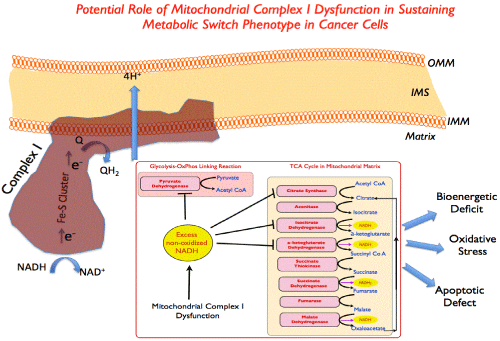
 |
| Figure 2: Putative schematic of mitochondrial complex I function in the decision making of cancer cell metabolic switch phenotype: Mitochondrial complex I serves as a gate keeper between the glycolytic/TCA cycle network and the electron transport chain activity in the mitochondria. This is the largest enzyme (45 subunits in mammalian enzyme) of the electron transport chain. Electrons generated via oxidation of NADH to NAD+ are transported via the iron-sulfur clusters within the peripheral arm of mitochondrial complex I (as shown) to reduce ubiquinol (Q to QH2) thereby transporting 4 protons from the matrix to the intermembrane space thereby significantly contributing to the mitochondrial membrane potential that is eventually used for ATP synthesis. Any dysfunction arising from structure assembly and/or functional aberration in the Complex I is expected to build up excess NADH at the first step of enzyme activity which will in turn, lead to a significant imbalance in the associated metabolic pathways as shown here. Overall mitochondrial dysfunction can lead to bioenergetics deficit, oxidative stress due to an increased free radical generation and apoptotic defects – all contributing directly to sustain the metabolic switch phenotype in cancer cells. |